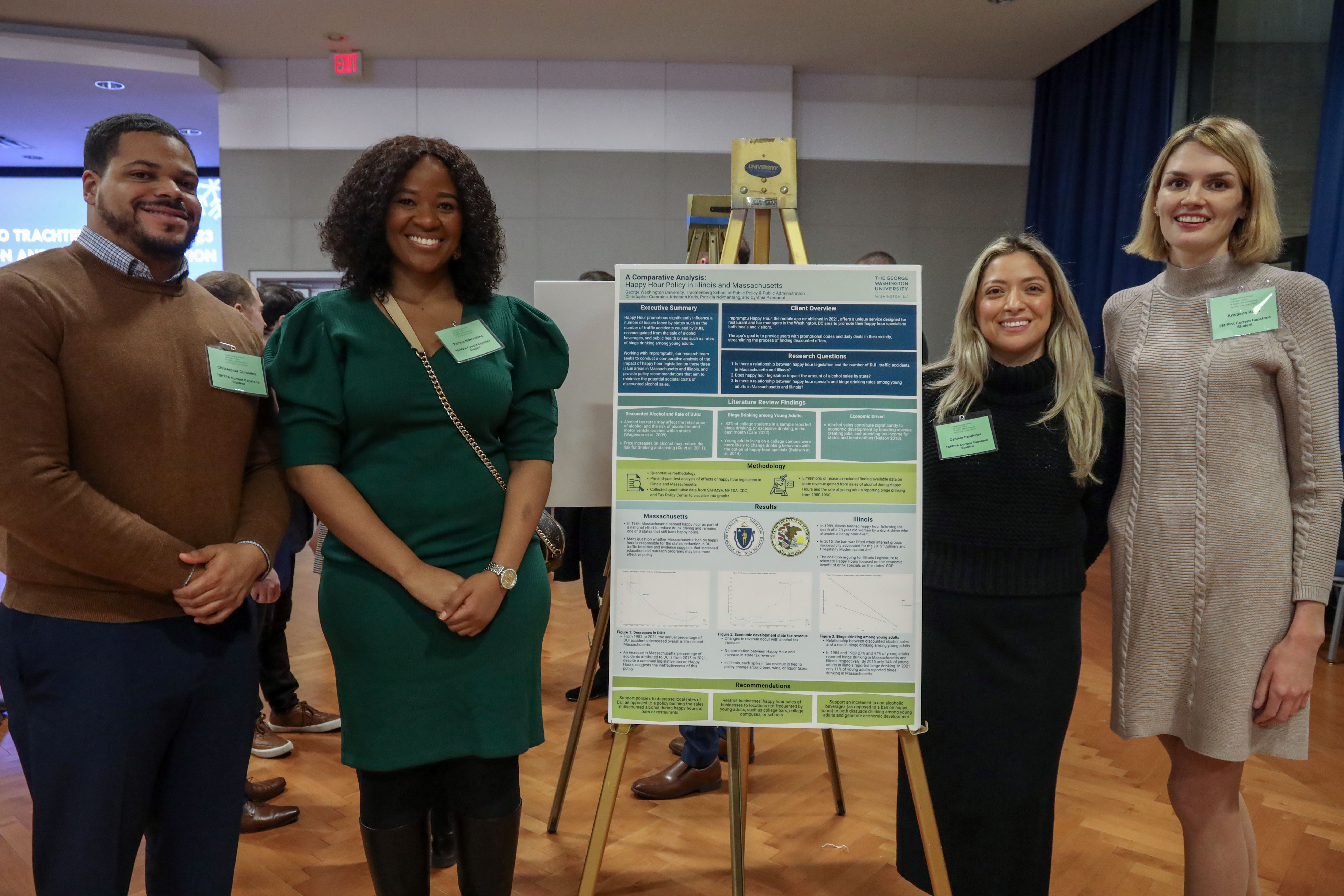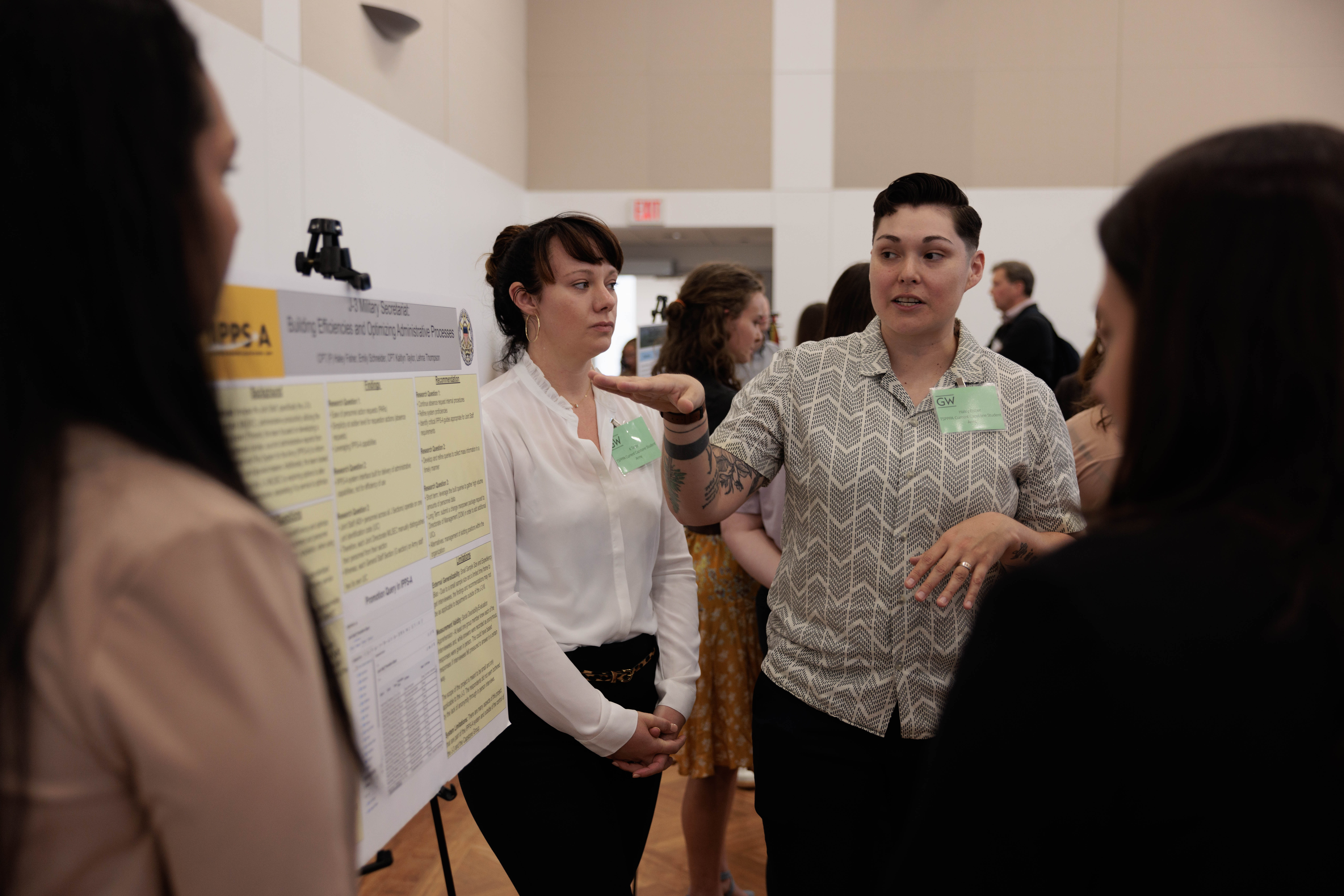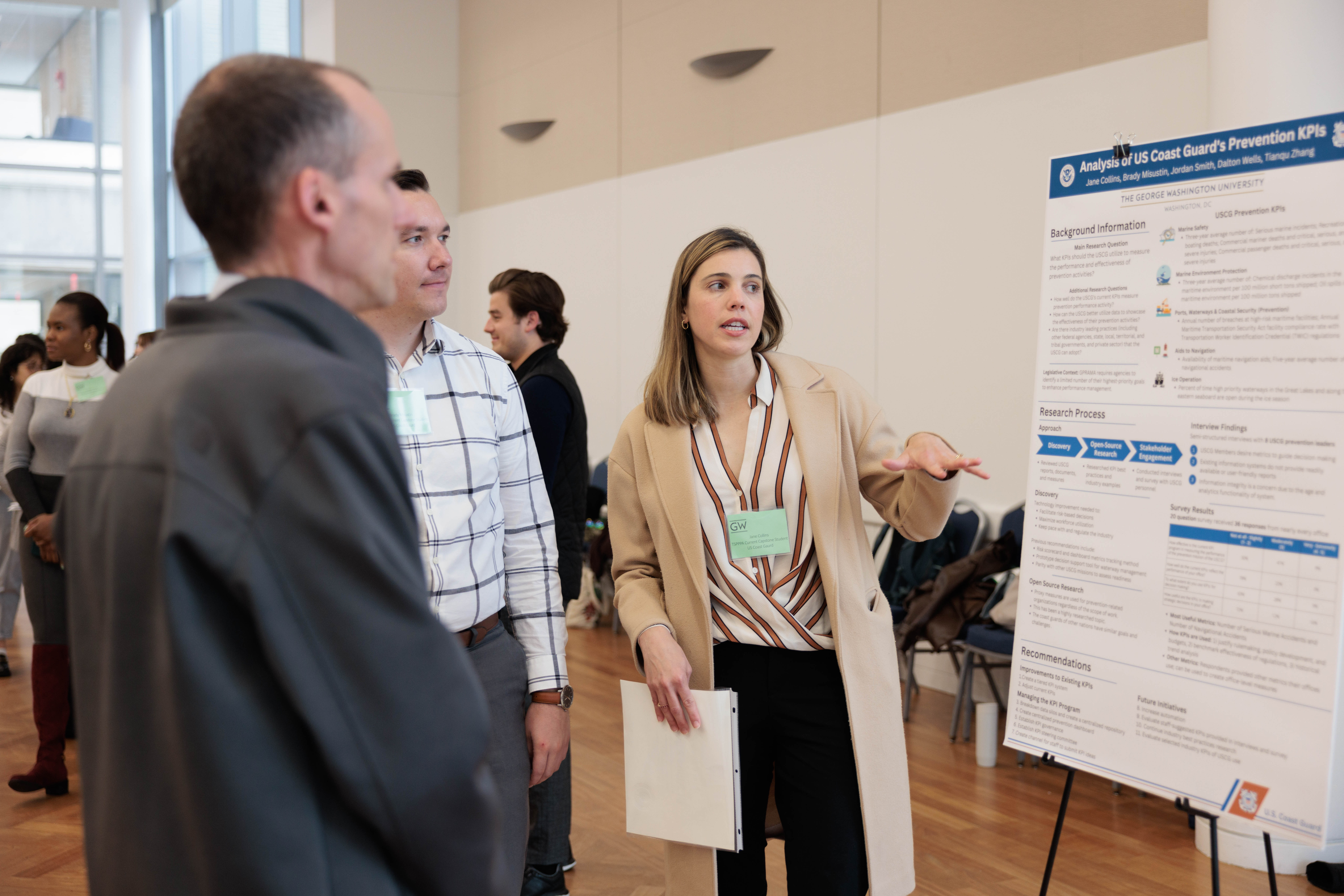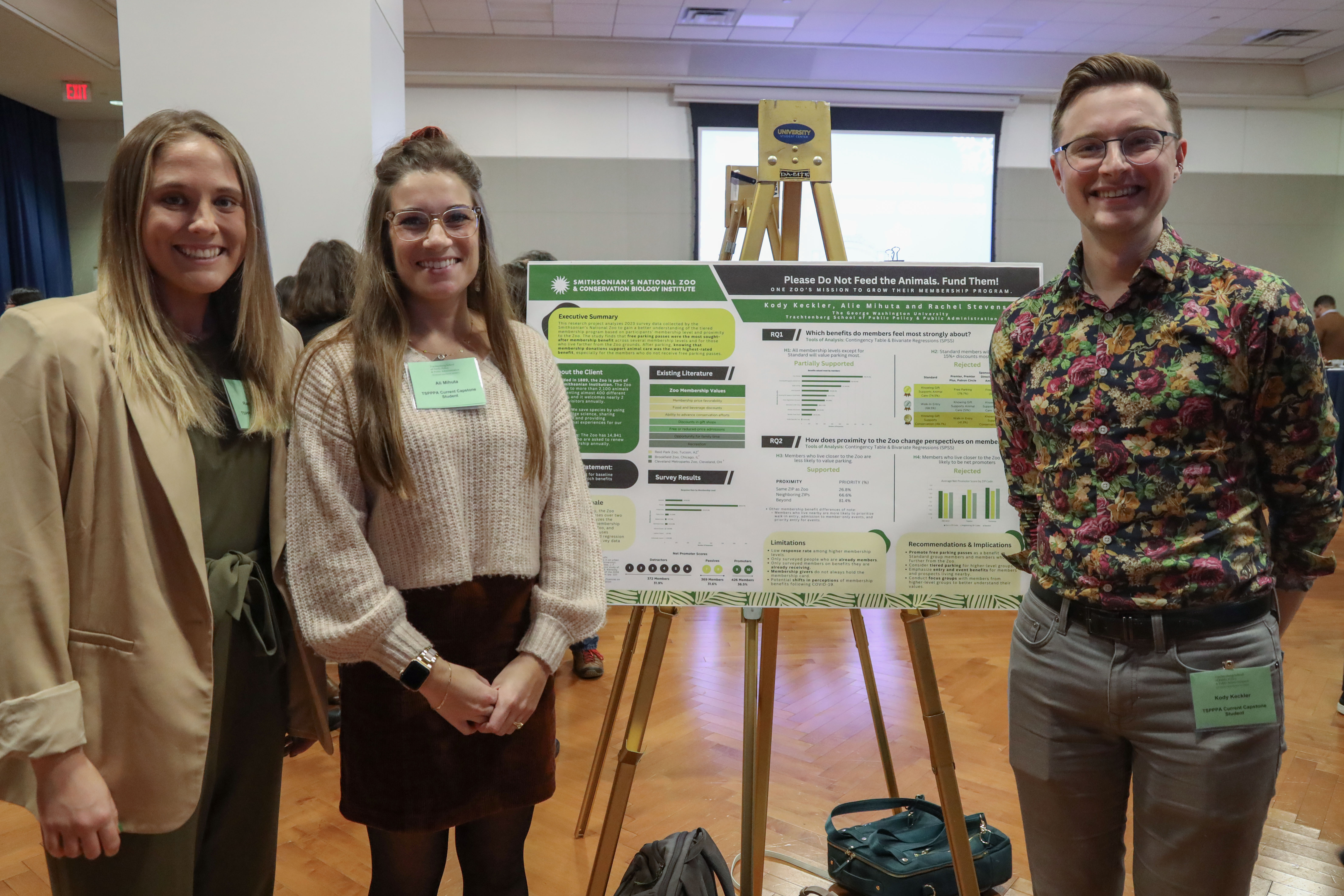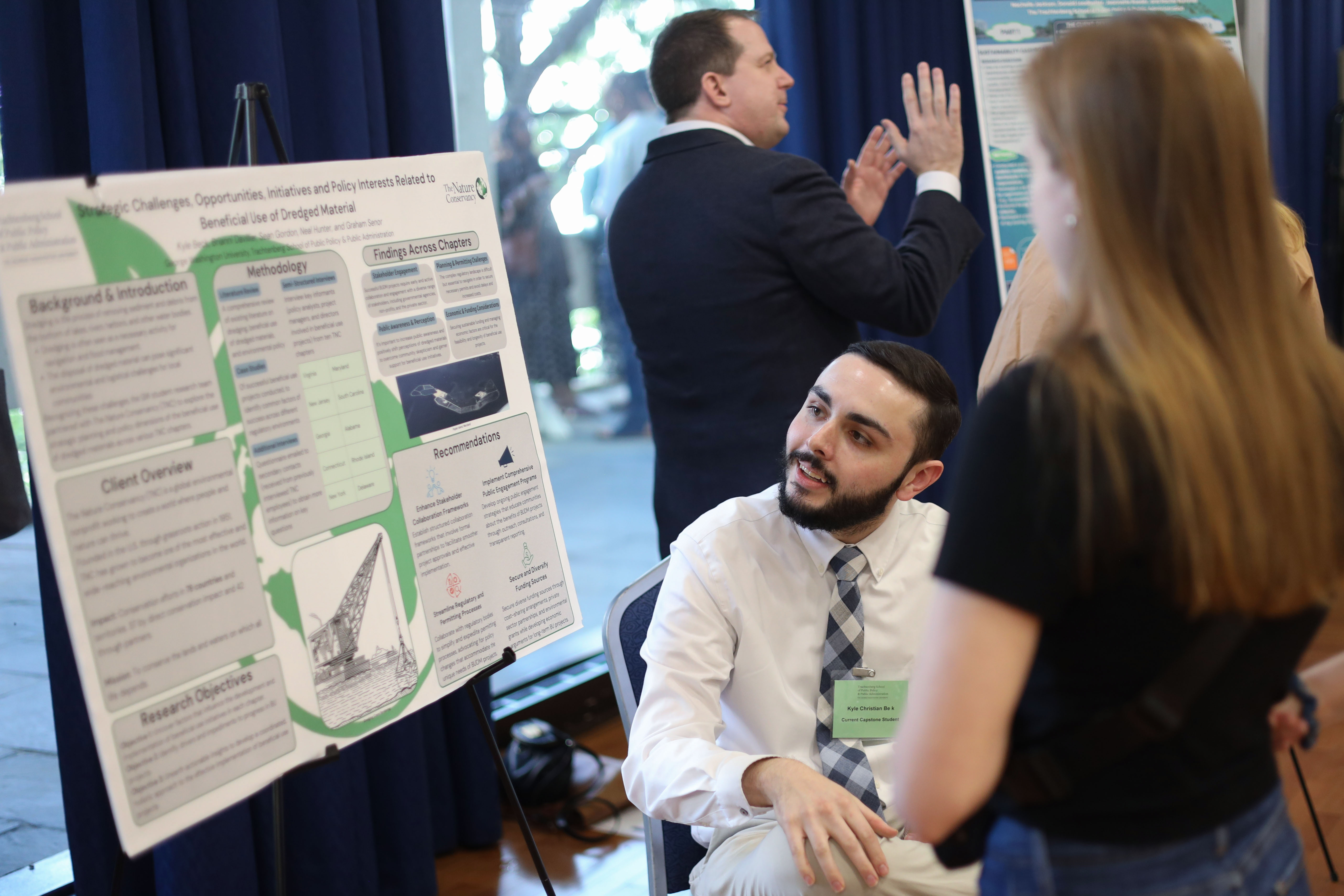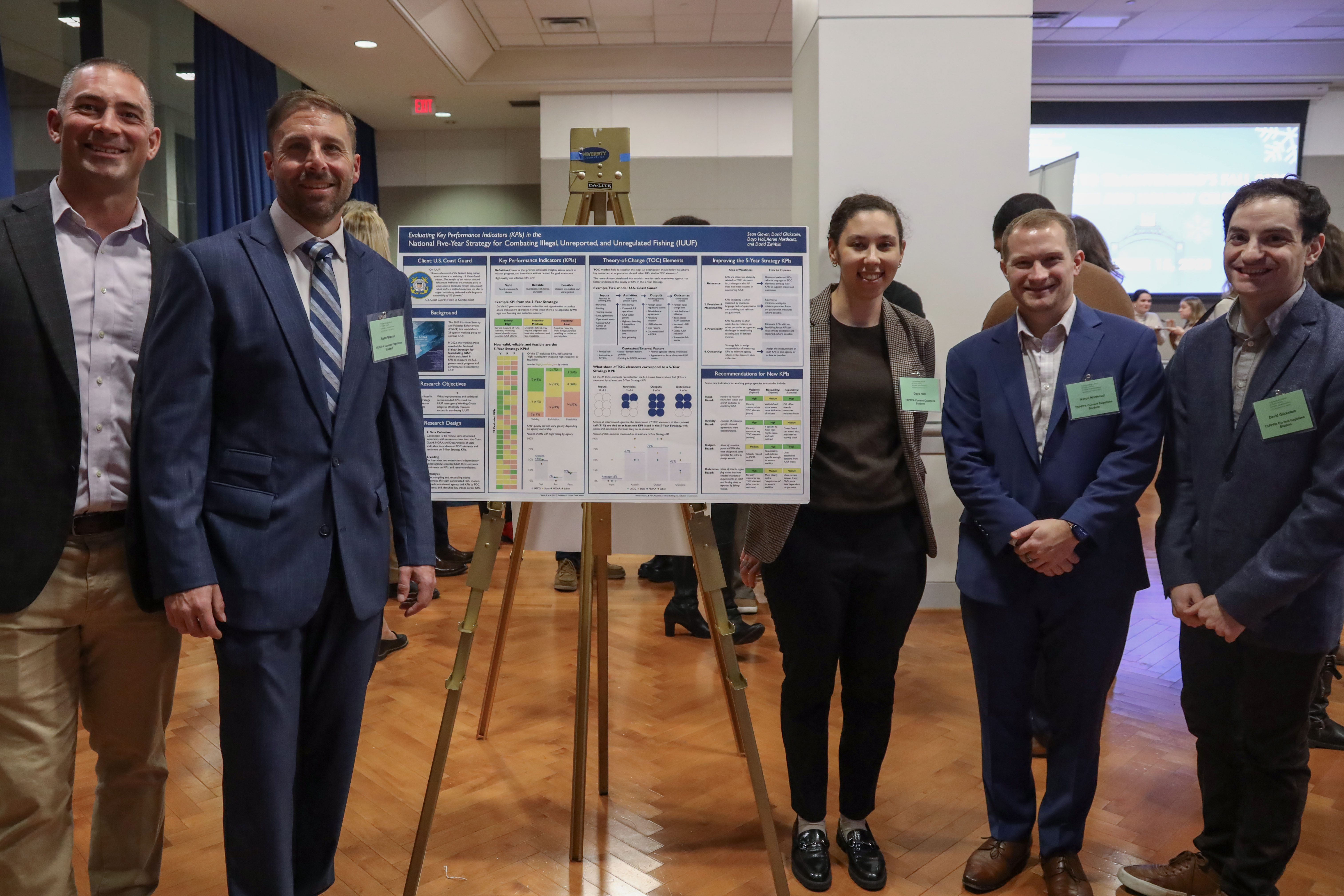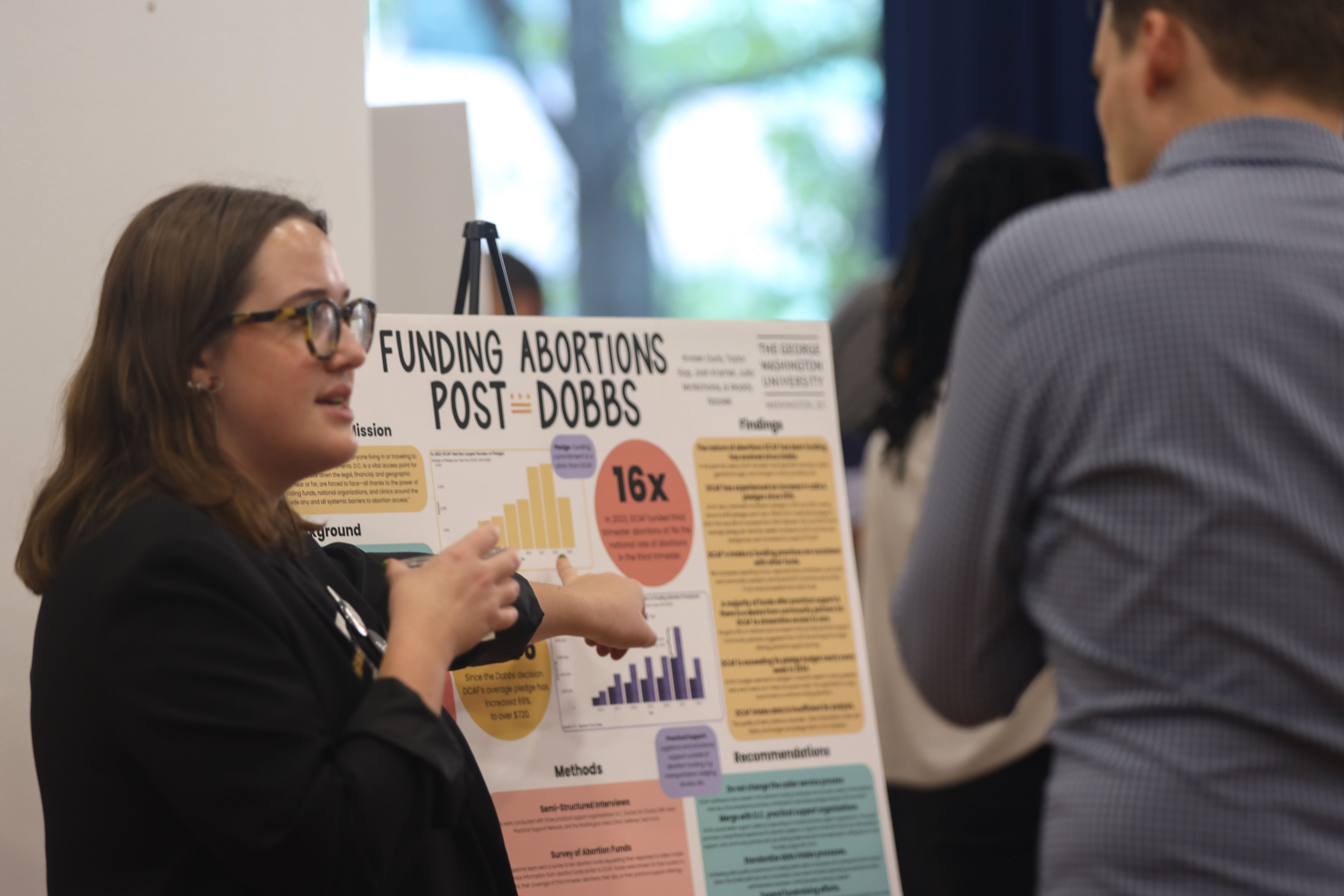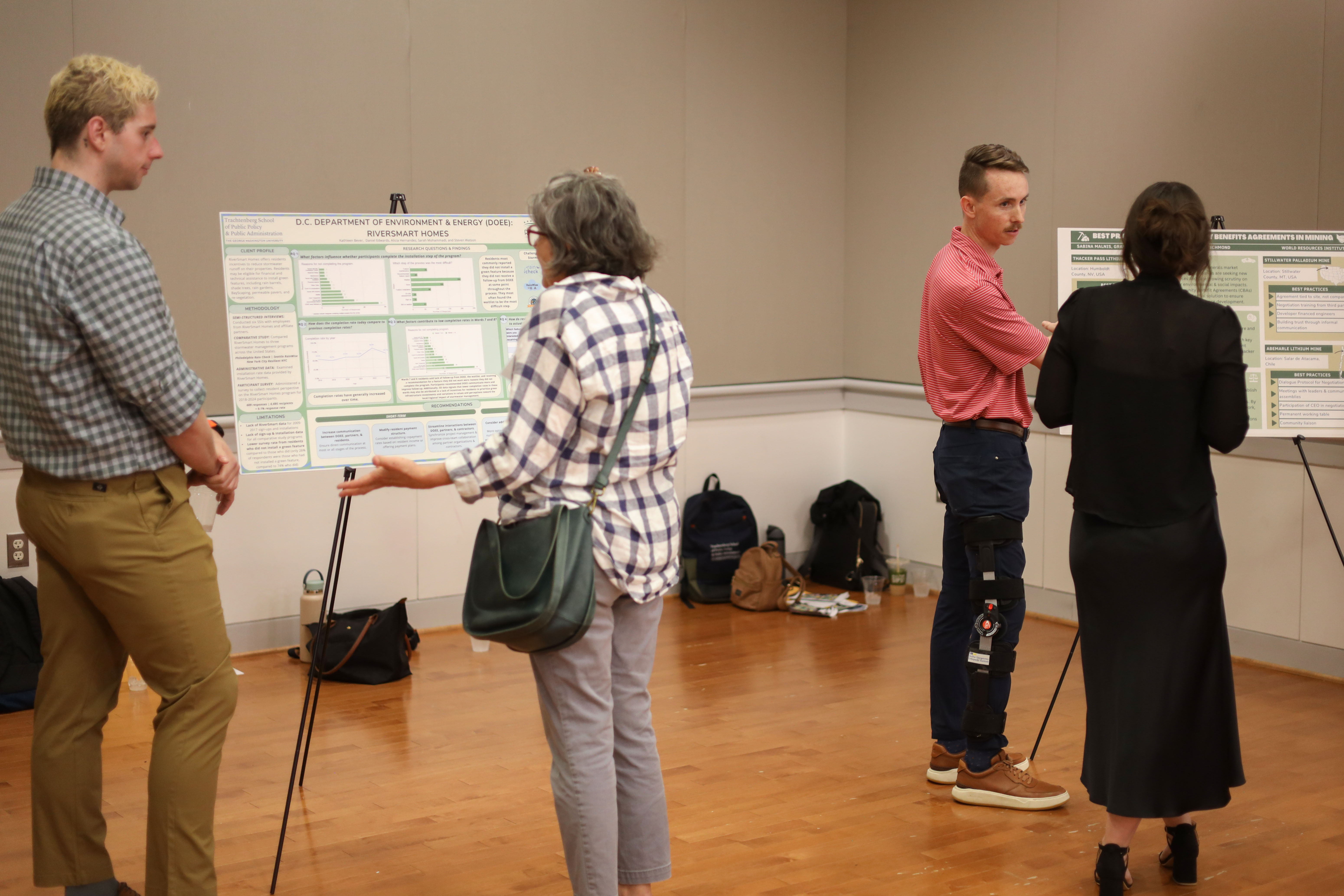Capstone Overview
Capstone Overview
The Trachtenberg School’s capstone course offers clients the opportunity to receive pro bono support from graduate students on a challenge they are facing. During the course, students design and implement substantial analytical projects for government agencies and nonprofit organizations. The culmination of each project results in a written report and a formal presentation of research results and recommendations to both the external client and the School community at our bi-annual Capstone Expo event. Trachtenberg students graduate with more than a degree; they have real-world consulting experience.

3-6
students typically work together on
the project and complete all work as a team
$0
cost to the client, and the pro bono work makes excellent material for résumés
14
different categories of capstone projects, from security policy to social justice, in recent years
8-10
weeks to complete the project, from defining the project scope to delivering a final report
Over the past three years, capstone projects have been completed in 14 categories:
- Childhood Development & Education
- Domestic Violence & Human Trafficking
- Energy, Environment, & Sustainability
- Engineering & Technology
- Government & Public Administration
- Healthcare
- Housing, Employment, & Poverty
- Hunger & Food Security
- International Development
- Other
- Security
- Social Justice Policy
- Urban Development & Transportation
- Veterans Affairs
For Clients: Exploring Capstone Projects and Collaborations
- What is the role of the client?
- Image

Due to the teams' constrained timeframe of 8-10 weeks, it becomes important for both the client and team to agree on a topic that holds significance and interest for both parties. Ensuring that the task is well-suited for the given time period and available resources is imperative. The creation of a research project that benefits both sides and is feasible often involves an iterative approach. This collaborative effort may continue to evolve even after the initial scope of work has been agreed upon.
Throughout this journey, the client plays a pivotal role by offering vital information and granting access to the required data to the student team. This partnership ensures that the research endeavor progresses smoothly and successfully.
- The client will agree on the project goal(s) and approach with their Capstone Team and Faculty Advisor, which may be an iterative process as findings or sources for data emerge
- The client will meet periodically with their Capstone team to check-in and provide feedback
- As appropriate, the client will help suggest sources and provide access to data
- We ask that the client offer honest feedback on project products and recommendations
- Note that team members should not be seen as interns or employees
- While not required, we encourage clients to attend our bi-annual Capstone Expo, wherein students will present their findings via poster to the larger Trachtenberg community.
- How can I apply to be a client?
- Please complete the capstone proposal form at this link.
- What is the project scope?
- Students may work on quantitative and/or qualitative capstone project
- These projects might include statistical computations, systems reviews, observation assessments, electronic surveys, interviews, evaluation protocols and tools, literature reviews, community asset mapping, data visualization, text thematic analysis, logic models, and case studies
- What are the project deliverables?
- At the end of the semester, capstone teams produce a professional, comprehensive written report to the client
- Teams will also present their research and recommendations to their client and the Trachtenberg community at our bi-annual Capstone Expo
- What works well?
- Clients have question(s) for their assigned team to answer using an evidence-based approach
- The projects must be feasible to deliver in one semester (8-10 weeks)
- Teams can complete tasks remotely and outside standard business hours
- Sources, data, and documents are immediately available or can be gathered within the timeframe
- Clients are supportive but do not manage the project
- Is there a cost to participate?
- There is no cost to the client
- Some projects incur additional costs beyond a team’s time. These may include, but are not limited to: software, materials, and transportation. Generally, we expect that the client would be responsible for these costs, however some funding may be available from the School (please include any funding requests in your initial proposal)
- What is the role of the student?
- The student will serve as an external consultant to the client, contributing approximately 10-15 hours per week
- They will honor any confidentiality agreements
- At the end of the semester, the student will provide a professional written report that can inform client decision-making
- What is the timeline?
For Fall Semester Capstone Projects:
- Client Interest Form Deadline: End of May/Early June (late submissions are possible)
- Notification of Project Selection: Late June
- Project Work Period: September - December
Capstone Expo: Early December
For Spring Semester Capstone Projects:
- Client Interest Form Deadline: Mid-October (late submissions are possible)
- Notification of Project Selection: November
- Project Work Period: January – May
Capstone Expo: Late April/early May
- Client Testimonials
Georgetown Main Street
"As a proud TSPPPA alumna, I understand the value of collaboration and knowledge-sharing. Partnering with TSPPPA Master's students for our Georgetown Main Street capstone project enhances our organization's capacity. Their research and project management provide invaluable support to our small team, driving meaningful progress within the Georgetown Main Street community."
- Rachel Shank, MPA '19, Executive Director, Georgetown Main Street
Refugee Council USA
"Our organization's expectations were tremendously exceeded by the TSPPPA capstone group. Their final product presented original research that comparatively analyzed refugee resettlement globally in a way that was easily digestible, professional, and highly informative."
- Emily Wood, Director of Programs, Refugee Council USA
GW Columbian College of Arts and Sciences
"I was very impressed by the degree of sophistication in research methods and data analysis that the students applied in their capstone project.
- John Philbeck, Vice Dean for Faculty Affairs, GW Columbian College of Arts and Sciences
Friendship Place
"As a small nonprofit that prides itself on having a strong culture of learning and evaluation, we still operate with a very small but mighty team of just two. Having a whole group of TSPPPA students join us on a project that would have otherwise not been possible to undertake was not only helpful but entirely exceeded our expectations. The students took innovative and robust approaches to the research and analysis in a way that gave us strong leverage to take the findings and recommendations to our partners and the City to hopefully improve the lives of unhoused DC residents for years to come."
- Rachel Yakobashvili, Friendship Place
The Nature Conservancy
"The students were organized, enthusiastic, thoughtful, and flexible. They pursued the research questions we posed and adapted to on the ground conditions in real time. The work they produced was valuable and will be leveraged by our team to advance equitable conservation policy and programs in practice."
- Isaac Hametz, The Nature Conservancy
For Students: Capstone Details
- How does the capstone course work?
- Capstone is a course that is required of all MA-ESP, MPA, and MPP students. Students will usually consult for a government agency or nonprofit organization, however, some for-profit companies may work with our students on a case-by-case basis.
- Students will build upon the skills that they have gained throughout their experience at Trachtenberg as this is the final class that they will embark upon during their program.
- This course is also meant to be an opportunity for students to work on their team-building skills in a professional setting.
- Because this is an academic course, student teams will be guided by a faculty instructor, however, the work will largely be student-driven.
- What is the role of the student?
- Image
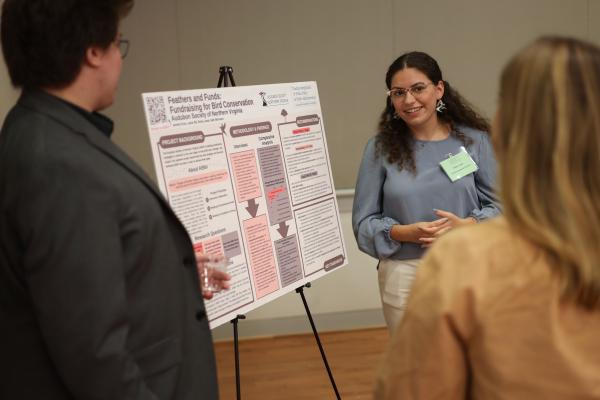
The capstone team’s role is similar to that of an external consultant. Using specifications and guidance from an external agency or nonprofit organization, the team will clarify project goals and identify who on the team will be responsible for each assignment. The team will submit a final report to the client agency and to Trachtenberg School faculty at the conclusion of the project. All members of the team will be equally responsible for the success of the project.
Accomplishing this ambitious goal – particularly in a one-semester time span – requires more than simple mastery of prior courses; it requires moving rapidly with adroit planning, aggressive time management, resourcefulness, and creativity.
Capstone teams produce a professional, comprehensive written report and oral presentation with the results of their work to the client at the end of the semester — early December for fall capstones and late April/early May for spring capstones.
- The student will serve as an external consultant to the client. Each student group will contribute approximately 10-15 hours per week.
- They will honor any confidentiality agreements.
- At the end of the semester, the student will provide a professional written report that can inform client decision-making
- How are projects selected?
Learn more about the client selection process here.
- How much time will an individual spend on the course per week?
- Teams contribute approximately 10-15 hours of work per week.
- A team will typically consist of three to six students.
- Can I nominate a client?
- Yes! Students can nominate a client if they have a specific project and employer in mind.
- Please note that your immediate supervisor is ineligible from also serving the role of client for your team.
- What are the capstone project goals?
- Identify and solve a real-world problem
- Work collaboratively with other students and relevant members of the client agency
- Integrate skills and knowledge gained from previous courses and experiences
- Practice the full complement of communication skills, including written reports and oral presentations
- Student Testimonials
"This project deepened my understanding of how sustainability can be integrated into tourism and destination marketing. I gained valuable experience in climate policy analysis, stakeholder engagement, and working with real-world data to develop practical solutions. It also strengthened my teamwork, research, and communication skills while reinforcing my commitment to using environmental policy to support more sustainable communities."
- Shwe Ye Han, MA-ESP
"I took a lot out of this project in learning how to apply the skills and knowledge I have learned throughout my degree to a real-life example. It was very rewarding to feel like we were making an impact in helping an amazing community organization realize their strengths and some areas where improvements could be made."
- Olivia Struttman, MPP
Capstone Project Examples
- Fight Colorectal Cancer
This project examined relationship between colorectal cancer incident rates and state- level policy implementation to identify barriers to receiving follow-up colonoscopies after positive test results. The student group utilized quantitative and qualitative methods including interviews, literature review, and statistical analyses.
- Horton's Kids
This project conducted an asset-mapping project in the Anacostia neighborhood of DC to help client better leverage community resources in support of their mission. The project included a literature review, and utilized a mixed method approach to identify gaps, create an asset map and complete a critical needs analysis.
- Center for Strategic and International Studies
This project analyzed the impact and effectiveness of US Investments in women and girl’s education in Afghanistan. The student group produced a statistical analysis of dollars invested and indicators such as education participation and completion; economic participation and empowerment, political participation, and democracy measures.
- Marshall Heights Community Organization
For this project, the student group produced a theory of change model that guides short and long-term actions to improve Single Room Occupancy Programming for the Homeless. They examined policy objectives, analyzed program implementation and success measures, as well as end user engagement through literature review, interviews, and surveys.
- Georgetown Main Streets
For this project, the student group recommended new feedback methods, improved metrics, and grantmaking processes based on an analysis of metrics & promising small business grant practices. They conducted quantitative surveys of 66 organizations, qualitative interviews, and literature review.
- Office of the DC Auditor
The student group produced a policy review, as well as analysis of implementation and impacts of NEAR Act in relation to Office of Police Complaint and Review Board. Through interviews, policy & literature review, they provided policy recommendations and key findings on policy adherence.
- DC Department of Energy and National Park Service
The student group created a cost benefit analysis framework for stream restoration in Rock Creek Park, identifying nearly USD 2M in costs, established environmental valuation of 6.6M, performed sensitivity analysis, and recommended further actions to increase ROI of restoration projects.
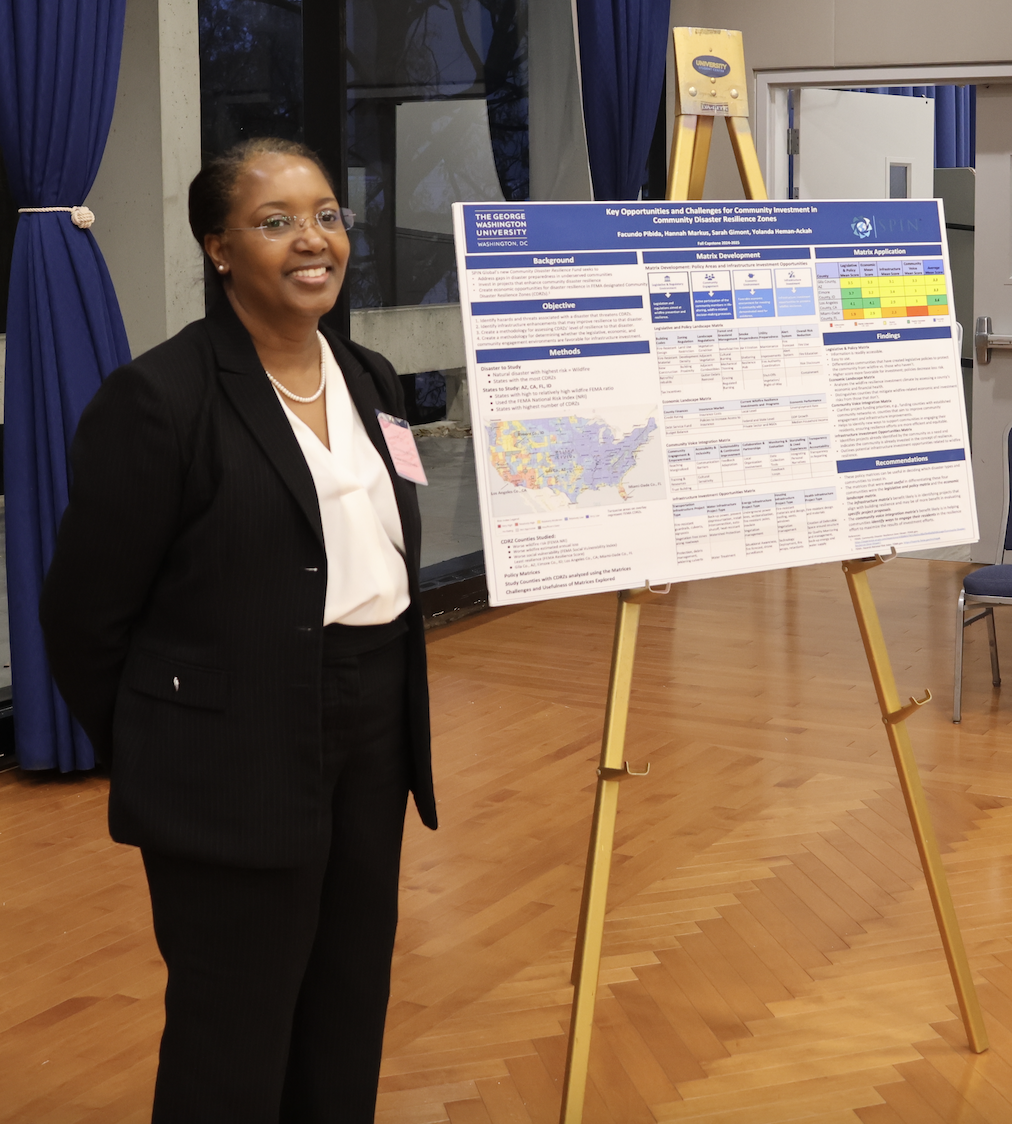
Capstone Feature: SPIN Global
A capstone project in the Fall 2024 semester titled "Key Opportunities and Challenges for Community Investment in Community Disaster Resilience Zones" with client SPIN Global conducted a report on wildfire resilience and impact funding to build. The client representative for SPIN Global was GW Board of Trustees Member and TSPPPA MPA alumna Camila Tapias. The project identified four particularly vulnerable sites, including Los Angeles, California. The research conducted also included extensive research on why Los Angeles is in need of help with wildfire resiliency and why the city is a critical area for future investment. The project was executed by Master's graduates Facundo Pibida, Hannah Markus, Sarah Gimont, and Yolanda Heman-Ackah.



